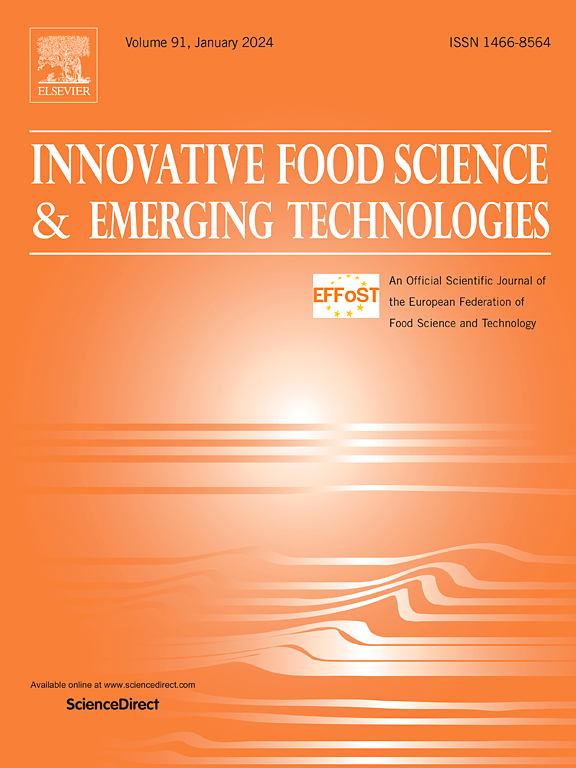Influence of cell disruption on techno-functional properties and digestibility of Chlorella vulgaris proteins
IF 6.3
1区 农林科学
Q1 FOOD SCIENCE & TECHNOLOGY
Innovative Food Science & Emerging Technologies
Pub Date : 2025-04-10
DOI:10.1016/j.ifset.2025.104023
引用次数: 0
Abstract
Due to their high protein content, low resource requirements, and high productivity, microalgae are a promising source of potentially sustainable and functional protein. However, the rigid cell wall of Chlorella vulgaris restricts protein bioaccessibility and reduces protein solubility. The latter restricts the techno-functional properties of the protein, presenting challenges for its use in food applications. This study evaluated the impact of cell disruption by high-pressure homogenization (HPH), bead milling (BM), and pulsed electric field (PEF), on protein digestibility and techno-functional properties. To examine the impact of each method, frozen-thawed C. vulgaris biomass was treated with HPH (600 bar and 1200 bar), BM (0.5 and 1 mm beads), and PEF (6 kV/cm, up to 100 kJ/kg). PEF had minimal impact on protein solubility and was excluded from further analysis. HPH and BM significantly improved protein solubility and enhanced in vitro protein digestibility (from 65 % to over 80 %). Emulsion droplet size was reduced, while foaming capacity and stability were enhanced by both HPH and BM. Similarly, these methods reduced the minimal gelling concentration and increased the oil holding capacity. These improvements make disrupted C. vulgaris a competitive alternative to conventional plant proteins. These findings highlight the potential of cell disrupted C. vulgaris as a potentially sustainable, versatile protein source for innovative food formulations.
细胞破坏对小球藻蛋白质技术功能特性和消化率的影响
微藻具有蛋白质含量高、资源需要量低、生产力高等特点,是一种具有潜在可持续性和功能性的蛋白质来源。然而,小球藻坚硬的细胞壁限制了蛋白质的生物可及性,降低了蛋白质的溶解度。后者限制了蛋白质的技术功能特性,为其在食品中的应用提出了挑战。本研究评估了高压均质(HPH)、珠磨(BM)和脉冲电场(PEF)对细胞破坏对蛋白质消化率和技术功能特性的影响。为了检验每种方法的影响,冻解冻的C. vulgaris生物质分别用HPH (600 bar和1200 bar)、BM(0.5和1 mm珠)和PEF (6 kV/cm,高达100 kJ/kg)处理。PEF对蛋白质溶解度的影响最小,因此被排除在进一步的分析之外。HPH和BM显著改善了蛋白质溶解度,提高了体外蛋白质消化率(从65%提高到80%以上)。HPH和BM均能减小乳液滴度,提高泡沫容量和稳定性。同样,这些方法降低了最小胶凝浓度,提高了储油能力。这些改进使得被破坏的C. vulgaris成为传统植物蛋白的竞争性替代品。这些发现突出了细胞破坏的C. vulgaris作为创新食品配方的潜在可持续、多功能蛋白质来源的潜力。
本文章由计算机程序翻译,如有差异,请以英文原文为准。
求助全文
约1分钟内获得全文
求助全文
来源期刊
CiteScore
12.00
自引率
6.10%
发文量
259
审稿时长
25 days
期刊介绍:
Innovative Food Science and Emerging Technologies (IFSET) aims to provide the highest quality original contributions and few, mainly upon invitation, reviews on and highly innovative developments in food science and emerging food process technologies. The significance of the results either for the science community or for industrial R&D groups must be specified. Papers submitted must be of highest scientific quality and only those advancing current scientific knowledge and understanding or with technical relevance will be considered.

 求助内容:
求助内容: 应助结果提醒方式:
应助结果提醒方式:


